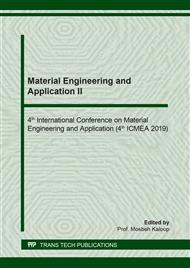[1]
Nippon Piston Ring Co.Ltd, Development of High Response Injector Parts by MIM process, Abstracts of Spring Meeting of Japan Society of Powder and Powder Metallurgy, (2002) 295.
Google Scholar
[2]
Committee for Metal Injection Molding, Metal Injection Molding technology for Mechanical designers, Japan Powder Metallurgy Association, Tokyo, (2015) 55-58.
DOI: 10.31399/asm.hb.v07.a0006141
Google Scholar
[3]
T. Kato, T. Tomioka, Magnetic Properties of Chromium Stainless Steel, Denki Seiko, 37 (1966) 265-272.
DOI: 10.4262/denkiseiko.37.265
Google Scholar
[4]
T. Kato, I. Sekio, K. Kusaka, Free-Machining Magnetic Core Stainless Steel, Denki Seiko, 41 (1970) 127-132.
DOI: 10.4262/denkiseiko.41.127
Google Scholar
[5]
H. Koide, Y. Kato, K. Tasaka, M. Fujita, T. Takagi, Development of Quick Response Injector for EFI System, TOYOTA Technical Rev. 35 (1985) 110-113.
Google Scholar
[6]
T. Kato, K. Kusaka, T. Kato, Magnetic Properties of Sintered Fe-Cr Alloys, Denki Seiko, 48 (1977) 144-150.
Google Scholar
[7]
M. Kawamura, T. Kohno, Improvement on Magnetic Properties of P/M Cr-Type Stainless Steel, Denki Seiko, 65 (1994) 145-150.
DOI: 10.4262/denkiseiko.65.145
Google Scholar
[8]
Y. Sano, T. Osada, K. Kudo, F. Tsumori, H. Miura, M. Tange, S. Tanaka, Effect of Cr Content on the Magnetic Properties of Fe-Cr Soft Magnetic Material by MIM Process, J. Jpn. Soc. Powder Metallurgy, 63 (2016) 291-296.
DOI: 10.2497/jjspm.62.431
Google Scholar
[9]
A. Saito, S. Yahagi, Y. Iwai, K. Takeuchi, A. Kuromiya, New Magnetic Stainless Steel for Electronic Fuel Injector, Bulletin of the Japan Institute of Metals, 29 (1990) 478-480.
DOI: 10.2320/materia1962.29.478
Google Scholar
[10]
T. Kato, I. Sekio, Effects of Silicon and Aluminum Contents on Properties of Free-Machining Magnetic Core Stainless Steel, Denki Seiko, 42 (1971) 41-54.
DOI: 10.4262/denkiseiko.42.41
Google Scholar
[11]
C. Lall, Soft Magnetism: Fundamentals for Powder Metallurgy and Metal injection Molding, MPIF, Princeton NJ, (1992) 64-67.
Google Scholar
[12]
T. Ototani, K. Yauchi, Y. Kataura, T. Fukuda, Effect of Melting Condition on the Properties of high Chromium Ferritic Steels, Tetsu-to-Hagané, 60 (1974) 1131-1143.
DOI: 10.2355/tetsutohagane1955.60.8_1131
Google Scholar


